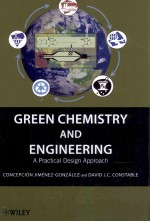图书介绍
GREEN CHEMISTRY AND ENGINEERING A Practical Design ApproachPDF|Epub|txt|kindle电子书版本网盘下载

- CONCEPCION JIMENEZ GONZALEZ 著
- 出版社: INC
- ISBN:9780470170878
- 出版时间:2011
- 标注页数:680页
- 文件大小:279MB
- 文件页数:694页
- 主题词:
PDF下载
下载说明
GREEN CHEMISTRY AND ENGINEERING A Practical Design ApproachPDF格式电子书版下载
下载的文件为RAR压缩包。需要使用解压软件进行解压得到PDF格式图书。建议使用BT下载工具Free Download Manager进行下载,简称FDM(免费,没有广告,支持多平台)。本站资源全部打包为BT种子。所以需要使用专业的BT下载软件进行下载。如BitComet qBittorrent uTorrent等BT下载工具。迅雷目前由于本站不是热门资源。不推荐使用!后期资源热门了。安装了迅雷也可以迅雷进行下载!
(文件页数 要大于 标注页数,上中下等多册电子书除外)
注意:本站所有压缩包均有解压码: 点击下载压缩包解压工具
图书目录
PART Ⅰ GREEEN CHEMISTRY AND GREEN ENGINEERING IN THE MOVEMENT TOWARD SUSTAINABILITY1
1 Green Chemistry and Engineering in the Context of Sustainability3
1.1 Why Green Chemistry?3
1.2 Green Chemistry, Green Engineering, and Sustainability6
1.3 Until Death Do Us Part: A Marriage of Disciplines13
Problems15
References15
2 Green Chemistry and Green Engineering Principles17
2.1 Green Chemistry Principles17
2.2 Twelve More Green Chemistry Principles26
2.3 Twelve Principles of Green Engineering28
2.4 The San Destin Declaration: Principles of Green Engineering31
2.5 Simplifying the Principles34
Problems38
References39
3 Starting with the Basics: Integrating Environment, Health,and Safety41
3.1 Environmental Issues of Importance42
3.2 Health Issues of Importance54
3.3 Safety Issues of Importance62
3.4 Hazard and Risk68
3.5 Integrated Perspective on Environment, Health, and Safety70
Problems70
References73
4 How Do We Know It's Green? A Metrics Primer77
4.1 General Considerations About Green Chemistry and Engineering Metrics77
4.2 Chemistry Metrics79
4.3 Process Metrics89
4.4 Cost Implications and Green Chemistry Metrics101
4.5 A Final Word on Green Metrics101
Problems102
References103
PART Ⅱ THE BEGINNING: DESIGNING GREENER, SAFER CHEMICAL SYNTHESES107
5 Route and Chemistry Selection109
5.1 The Challenge of Synthetic Chemistry109
5.2 Making Molecules110
5.3 Using Different Chemistries119
5.4 Route Strategy122
5.5 Protection-Deprotection124
5.6 Going from a Route to a Process126
Problems127
References130
6 Material Selection: Solvents, Catalysts, and Reagents133
6.1 Solvents and Solvent Selection Strategies133
6.2 Catalysts and Catalyst Selection Strategies154
6.3 Other Reagents168
Problems168
References173
7 Reaction Conditions and Green Chemistry175
7.1 Stoichiometry176
7.2 Design of Experiments178
7.3 Temperature180
7.4 Solvent Use182
7.5 Solvents and Energy Use184
7.6 Reaction and Processing Time187
7.7 Order and Rate of Reagent Addition188
7.8 Mixing189
Appendix 7.1: Common Practices in Batch Chemical Processing and Their Green Chemistry Impacts191
Problems196
References200
8 Bioprocesses203
8.1 How Biotechnology Has Been Used203
8.2 Are Bioprocesses Green?204
8.3 What Is Involved in Bioprocessing205
8.4 Examples of Products Obtained from Bioprocessing216
Problems226
References232
PART Ⅲ FROM THE FLASK TO THE PLANT: DESIGNING GREENER, SAFER, MORE SUSTAINABLE MANUFACTURING PROCESSES233
9 Mass and Energy Balances235
9.1 Why We Need Mass Balances, Energy Balances, and Process Flow Diagrams236
9.2 Types of Processes237
9.3 Process Flow Diagams238
9.4 Mass Balances241
9.5 Energy Balances250
9.6 Measuring Greenness of a Process Through Energy and Mass Balances261
Problems265
References272
10 The Scale-up Effect273
10.1 The Scale-up Problem273
10.2 Factors Affecting Scale-up276
10.3 Scale-up Tools283
10.4 Numbering-up vs. Scaling-up289
Problems290
References293
11 Reactors and Separations295
11.1 Reactors and Separations in Green Engineering296
11.2 Reactors296
11.3 Separations and Other Unit Operations307
11.4 Batch vs. Continuous Processes321
11.5 Does Size Matter?323
Problems323
References327
12 Process Synthesis331
12.1 Process Synthesis Background331
12.2 Process Synthesis Approaches and Green Engineering333
12.3 Evolutionary Techniques334
12.4 Heuristics Methods343
12.5 Hierarchical Decomposition346
12.6 Superstructure and Multiobjective Optimization349
12.7 Synthesis of Subsystems354
Problems355
References359
13 Mass and Energy Integration363
13.1 Process Integration: Synthesis, Analysis,and Optimization363
13.2 Energy Integration365
13.3 Mass Integration373
Problems381
References388
14 Inherent Safety391
14.1 Inherent Safety vs. Traditional Process Safety391
14.2 Inherent Safety and Inherently Safer Design394
14.3 Inherent Safety in Route Strategy and Process Design398
14.4 Conclusions on Inherent Safety406
Problems406
References411
15 Process Intensification413
15.1 Process Intensification Background413
15.2 Process Intensification Technologies416
15.3 Process Intensification Techniques435
15.4 Perspectives on Process Intensification437
Problems437
References442
PART IV EXPANDING THE BOUNDARIES447
16 Life Cycle Inventory and Assessment Concepts449
16.1 Life Cycle Inventory and Assessment Background450
16.2 LCI/A Methodology452
16.3 Interpretation: Making Decisions with LCI/A473
16.4 Streamlined Life Cycle Assessment481
Problems484
References488
17 Impacts of Materials and Procurement493
17.1 Life Cycle Management493
17.2 Where Chemical Trees and Supply Chains Come From495
17.3 Green (Sustainable) Procurement500
17.4 Transportation Impacts511
Problems515
References517
18 Impacts of Energy Requirements519
18.1 Where Energy Comes From519
18.2 Environmental Life Cycle Emissions and Impacts of Energy Generation525
18.3 From Emissions to Impacts537
18.4 Energy Requirements for Waste Treatment540
Problems540
References542
19 Impacts of Waste and Waste Treatment545
19.1 Environmental Fate and Effects Data546
19.2 Environmental Fate Information: Physical Properties550
19.3 Environmental Fate Information: Transformation and Depletion Mechanisms557
19.4 Environmental Effects Information559
19.5 Environmental Risk Assessment562
19.6 Environmental Life Cycle Impacts of Waste Treatment565
Problems574
References576
20 Total Cost Assessment579
20.1 Total Cost Assessment Background579
20.2 Importance of Total Cost Assessment580
20.3 Relationship Between Life Cycle Inventory/Assessment and Total Cost Assessment582
20.4 Timing of a Total Cost Assessment583
20.5 Total Cost Assessment Methodology583
20.6 Total Cost Assessment in a Green Chemistry Context589
Problems594
References597
PART Ⅴ WHAT LIES AHEAD599
21 Emerging Materials601
21.1 Emerging Materials Development601
21.2 Nanomaterials602
21.3 Bioplastics and Biopolymers605
21.4 About New Green Materials609
Problems609
References611
22 Renewable Resources613
22.1 Why We Need Renewable Resources613
22.2 Renewable Materials616
22.3 The Biorefinery621
22.4 Renewable Energy625
Problems630
References632
23 Evaluating Technologies635
23.1 Why We Need to Evaluate Technologies and Processes Comprehensively635
23.2 Comparing Technologies and Processes636
23.3 One Way to Compare Technologies637
23.4 Trade-Offs644
23.5 Advantages and Limitations of Comparing Technologies645
Problems646
References649
24 Industrial Ecology651
24.1 Industrial Ecology Background652
24.2 Principles and Concepts of Industrial Ecology and Design655
24.3 Industrial Ecology and Design657
24.4 Industrial Ecology in Practice663
Problems665
References666
25 Tying It All Together: Is Sustainability Possible?669
25.1 Can Green Chemistry and Green Engineering Enable Sustainability?670
25.2 Sustainability: Culture and Policy671
25.3 Influencing Sustainability672
25.4 Moving to Action674
Problems674
References675
INDEX677